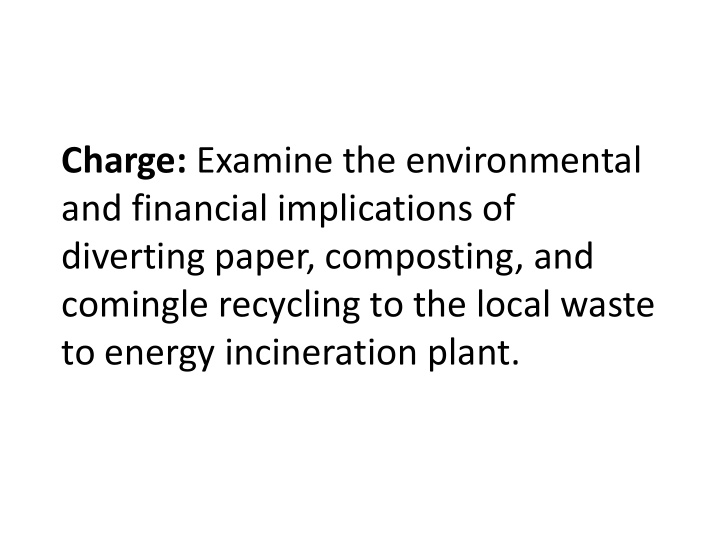



Charge: Examine the environmental and financial implications of diverting paper, composting, and comingle recycling to the local waste to energy incineration plant.
Existing Condition- Total Waste Waste Tonnage by Year 2,000.0 1,781.0 1,664.7 1,800.0 1,735.2 1,600.0 1,400.0 1,505.9 1,275.8 Tonnage 1,200.0 Total Waste 1,000.0 1,153.2 MSW 800.0 Total Recycling 600.0 459.4 400.0 511.5 200.0 275.1 - 2014 2015 2016 Calendar Year
Existing Condition- Total Waste Waste by Percent Type by Year 90% 74% 80% 85% 70% Percent of Total 60% 69% 50% 40% MSW 30% Total Recycling 31% 20% 26% 10% 15% 0% 2014 2015 2016 Calendar Year
Existing Condition- Recycled Waste Tonnage of Recyled Materials by Type 600 511.5 500 459.4 400 356.0 Total Recycling Tonnage 275.1 277.8 300 Glass, Cans, Plastic Bottles Paper (Incl. Composting) 184.3 200 Scrap Metals 95.8 100 72 Other 46.7 46.7 45.7 25.0 39.1 37.8 0 19.1 2014 2015 2016 Calendar Year
Existing Condition- Recycled Waste Recycling by Percent Type by Year 80% 70% 67% 70% 60% 60% Percent of Total 50% Glass, Cans, Plastic Bottles 40% Paper (Incl. Composting) 30% Scrap Metals 21% 17% 20% Other 14% 10% 9% 10% 9% 9% 7% 7% 0% 2014 2015 2016 Calendar Year
Environmental Impact of WTE by Fuel Source • Life Cycle Cost Analysis Comparisons – In every study we reviewed recycling, when compared to landfilling, was said to create lower air emissions including lower life cycle GHG emissions. – In most studies recycling, when compared WTE, was also said to create lower air emissions including lower life cycle GHG emissions. – Not all studies considered all variables
Environmental Impact of WTE by Fuel Source • One study which reviews 9 different LCAs including 73 different scenarios found that most scenarios favored recycling paper and cardboard over WTE. • Other studies found similar results but showed that the benefits of recycling paper products and plastics were marginal or non existent compared to WTE in some conditions.
Health Impacts of WTE • Summary from a 2008 British Study – Higher rates of cancer and birth defects found around municipal waste incinerators. – Increased particulate pollution known to cause cardiovascular mortality; lung cancer; asthma, and COPD – Increases in heavy metals emissions know to cause neurological issues, particularly during early developmental periods.
Cost Savings From Proposal Incineration Added Hauling Costs Incineration Cost $ 117,088 Incineration and composting cost $ 105,906 Annual Added Cost $ 11,181 Operating Savings 1 Moving and Storage Specialist $ 32,099 Benefits (43%) $ 13,803 Maintenance (Trucks+Equip) $ 4,000 Fuel $ 600 Annual Savings $ 50,502 Total Annual Savings $ 39,320 Carbon Offsets $ (21,526) Net Annual Savings $ 17,794 One Time Savings 2 Trucks $ 4,000 Bailer $ 10,000 Shredder $ 25,000 Total One Time Savings $ 39,000
Recommend
More recommend